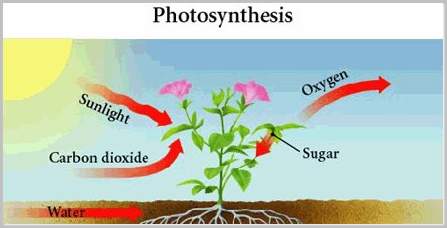Photosynthesis is a process by which plants utilize carbon dioxide and water in the presence of sunlight to produce glucose and oxygen. It is in fact a process that is very simple to understand. The roots of plants absorb water from the soil. This water travels through the xylem vessels of the vascular system to the green leafy parts of the plant.
The green leaves are characteristic of the pigment chlorophyll. Chlorophyll has the potential to trap sunlight in chemical form. Approximately 673,000 calories per mole of solar energy is trapped for the process of photosynthesis. The plant breathes in carbon dioxide from the atmosphere by a process of diffusion through the stomata of the leaves, which when combined with water in the presence of sunlight in green leaves produces carbohydrate and oxygen.
6(CO2) + H2O – – – 673 K cal of light energy – – – > C6H12O6 + 6(O2)
C6H12O6 is Glucose and the resulting by-product oxygen is released into the atmosphere during the day. The spongy parenchyma and palisade parenchyma have an abundant supply of chloroplasts which are rich in chlorophyll pigments.
Read also: Photosynthesis Process Step by Step
Raw materials of photosynthesis:
The raw materials of photosynthesis are Water, Carbon dioxide, sunlight and chlorophyll. All these four photosynthetic elements are required for the success of the process.
Product of Photosynthesis:

Glucose is the end result of photosynthesis. It is a sugar and the starter compound for the formation of food and other complex compounds in the plant. It is converted into carbohydrates like starch, instrumental in the formation of oils, and also combines with nitrogen, sulphur, phosphorus, etc, to form complex proteins and amino acids. Cellulose, rubber, alcohol, resin, plastic and numerous drugs from plants are a result of photosynthesis.
By-product of photosynthesis:
Oxygen is the by-product of photosynthesis. It is released during the day in the presence of sunlight. It is a process by which plants contribute fresh oxygen to the atmosphere. The release of oxygen also acts as a cooling effect. Large scale deforestation, unnecessary cutting down of trees and open land hinder the cycle of air purification brought about as a result of photosynthesis.
Importance of photosynthesis:
Plants form the basis of the food chain. The energy stored in green plants, the factories for carbohydrate synthesis, is consumed by man and animals. It forms a major source of fresh food. In addition to this, the stored chemical energy in plants that have died and over the ages converted to wood, coal and petroleum are chief sources of energy for mechanical and fuel purposes.

